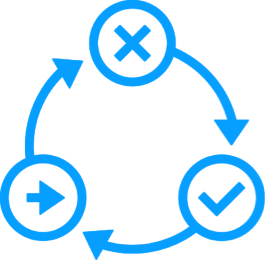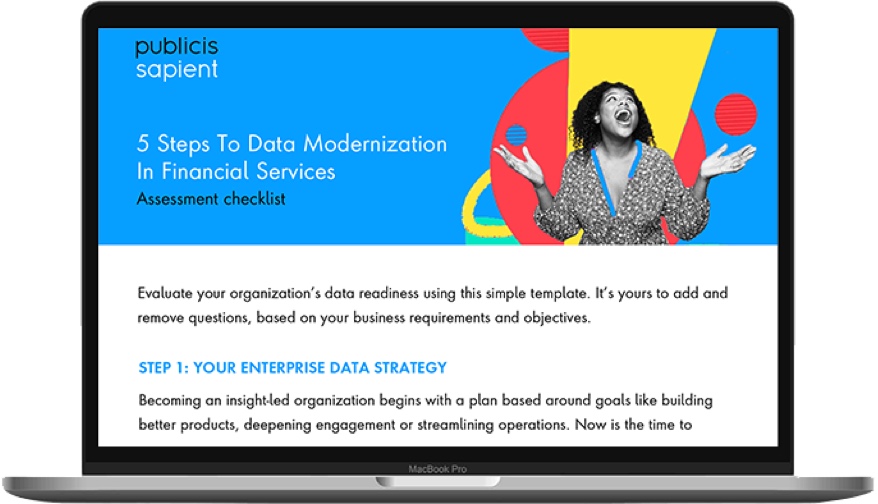What issue can we solve for you?
Type in your prompt above or try one of these suggestions
Suggested Prompt


More effective data integration and management hold the key for banks, insurers, asset managers and other financial services firms to generate actionable customer insights and enhance their personalization capabilities.
Financial services organizations are notable for having big balance sheets and huge amounts of capital. The size and extent of their data holdings are just as impressive. Banks, insurers, asset managers and other institutions certainly have more than enough data to generate high-value insights about their customers, segment them more precisely and make personalized offers. But relatively few reap the benefits.
A set of longstanding challenges prevent many marketing organizations in financial services from moving the needle on key outcomes, such as upselling and engagement, relative to their campaigns. Problems related to the quality, accessibility and actionability of data make it hard to reach customers with appropriate messaging and timely offers.
Connecting data and teams for richer customer views
The underlying issue is the difficulty of integrating data in the right systems to support data-driven decisioning and the generation of actionable insights. In other words, managing the data for proper use is a tougher challenge than just getting it in the first place.
Cultural or organizational factors also play a role. To a large extent, engineering and technology folks don’t fully understand marketing and the data and insights needed to boost performance. It’s also safe to say that marketing teams don’t always speak the same language as IT or understand what’s possible with analytics and other toolsets.
These disconnects often mean that true data consolidation never really happens; data from owned, paid and earned channels, as well as first-party data, is stored in different, and often incompatible, repositories. When data is siloed in these ways, the accuracy of insights suffers greatly and marketers are prevented from gaining truly 360-degree views of customers and prospects. Indeed, most financial services firms are probably in the 180- to 270-degree range when it comes to their customer perspectives.
Most firms are in the 180- to 270-degree range when it comes to their customer perspectives.
On a practical basis, this means that, for example, private banking units may not know that one of their clients is already a mortgage customer and thus a great candidate for a jumbo mortgage on a second home. But no matter how far around their customers banks can currently see, the goal is to use data to add more dimensions and enable more precise visibility and, ultimately, more personalized offerings.
Getting the right data and optimizing the mix
Data integration is also critical given the amount and variety of data financial services firms need to compete. As opposed to using just a few, broad attributes (age, gender, income level), customer profiles today have much richer information about life events, personal interests and psychographics (e.g., Website traffic, mobile app usage). In fact, top-performing marketing groups in financial services typically have data on hundreds of attributes about their customers.
When firms complement their own data holdings with third-party behavioral data (e.g., TV viewing habits, spending information), they gain much clearer pictures of both current and future customers. The ideal is to know not just what customers want, but also why they want it, which messages are most likely to resonate with them, and when, where and how they’re most likely to buy.
Many banks, insurers and asset managers have both B2B and B2B2C use cases, in addition to direct B2C relationships. That means they need contact and transactional data on multiple levels, from customers and users, to client, company and firm. Augmenting first-party data with third-party data at each of these levels is valuable but there is great variety among data providers across regions and markets. The bottom line is that a robust platform for data ingestion and a strong, flexible and extensible data model are critically important.
Seeking incremental value on a long-term journey
Integrating data to generate customer insight is a significant undertaking for any enterprise. If it were easy, every firm in financial services would have done it long ago. But those firms that take a progressive and iterative approach in creating a robust data ecosystem will realize value along the journey (which of course will be a long one).
A great first step is to make sure that the marketing and personalization use cases are clearly defined and prioritized. That insight will make it easier to identify and fulfill the data needs for those use cases (including analytical use cases for measurement). It's also important to recognize that the issues of data quality and usability will only become more important as we enter the post-cookie world. To build people-based audiences, banks will rely more on their first-party data, which helps explain the rising importance of customer data platforms (CDPs).
Among the other key steps for banks to take:
-
Solving for incompatible systems
this is an arduous and expensive task but one that’s still essential to complete, given the fragmented data environments many banks currently have in place (which have resulted largely from years of M&A activity); new technology, including CDPs, can help banks break down the organizational silos that prevent 360-degree views and effective personalization.

-

Enriching the profiles
the most advanced personalization capabilities will result from adding third-party data, especially behavioral data, to existing customer profiles; top performers look for hundreds of additional attributes because that’s where they can uncover many powerful insights.
-
Focusing on identity resolution
the most pressing, data-oriented use case for banks is the resolution of conflicting or incomplete customer identities across the business and in the broader digital world.

-

Driving to contextual (and actionable) insights
interpreting signals relative to customer intent is the goal; in designing and refining their data environments and analytical toolsets, banks must consider the needs of the business and technical users (e.g., data scientists).
-
Democratizing data
a robust data catalog, strong data governance and intuitive self-service tools can put real power in the hands of marketing, sales and analytical teams; they can understand what data is available, where and how to access it and what’s permissible to use (in light of legal, risk and regulatory compliance guidelines); empowering users, rather than having them rely on specialized teams for segmentation and insights generation, can unleash the value of data and drive big gains in personalization and analytics/reporting.

-

Thinking programmatically
beyond the knowledge of data scientists, marketing analysts and other individual users, companies need to establish automated decisioning and workflows (e.g., around next-best actions and offers) and connect data repositories to MarTech systems used across the business if they are to drive personalization at scale and automate campaign management.
-
Testing and learning
optimizing data management is an ongoing process, so banks must take the long-term view in integrating data for use in personalization campaigns; the test-and-learn mindset applies equally to IT integrating data sets as it does to marketers experimenting with segmentation models.

In the age of personalization, it won’t necessarily be firms with the most data that win as much as it will be those that are able to generate the most value from what they have. Integrating diverse data sets and empowering marketing and analytical users to explore that data and use it appropriately are just two ways financial services firms can do more with their data.

Are you data-ready?
Download our simple five-point checklist to find out whether you’re making the most out of your data.
Related Reading
-
![]()
Pathway to Personalization:
Banks Can Use Cloud to Personalize Everything
By modernizing their cloud computing environments and capabilities, banks can enhance their ability to deliver personalized offers, experiences and campaigns.
-
![]()
Pathway to Personalization:
What Omnichannel Means Today
In consumers’ eyes there’s no such thing as a channel, which is why banks must develop truly Omni-channel capabilities.
-
![]()
Pathway to Personalization:
How Banks Can Achieve Smarter Customer Segmentation at Scale
AI and machine learning give banks the power to better understand banking patterns in the digital world and more efficiently target their most likely future customers.









